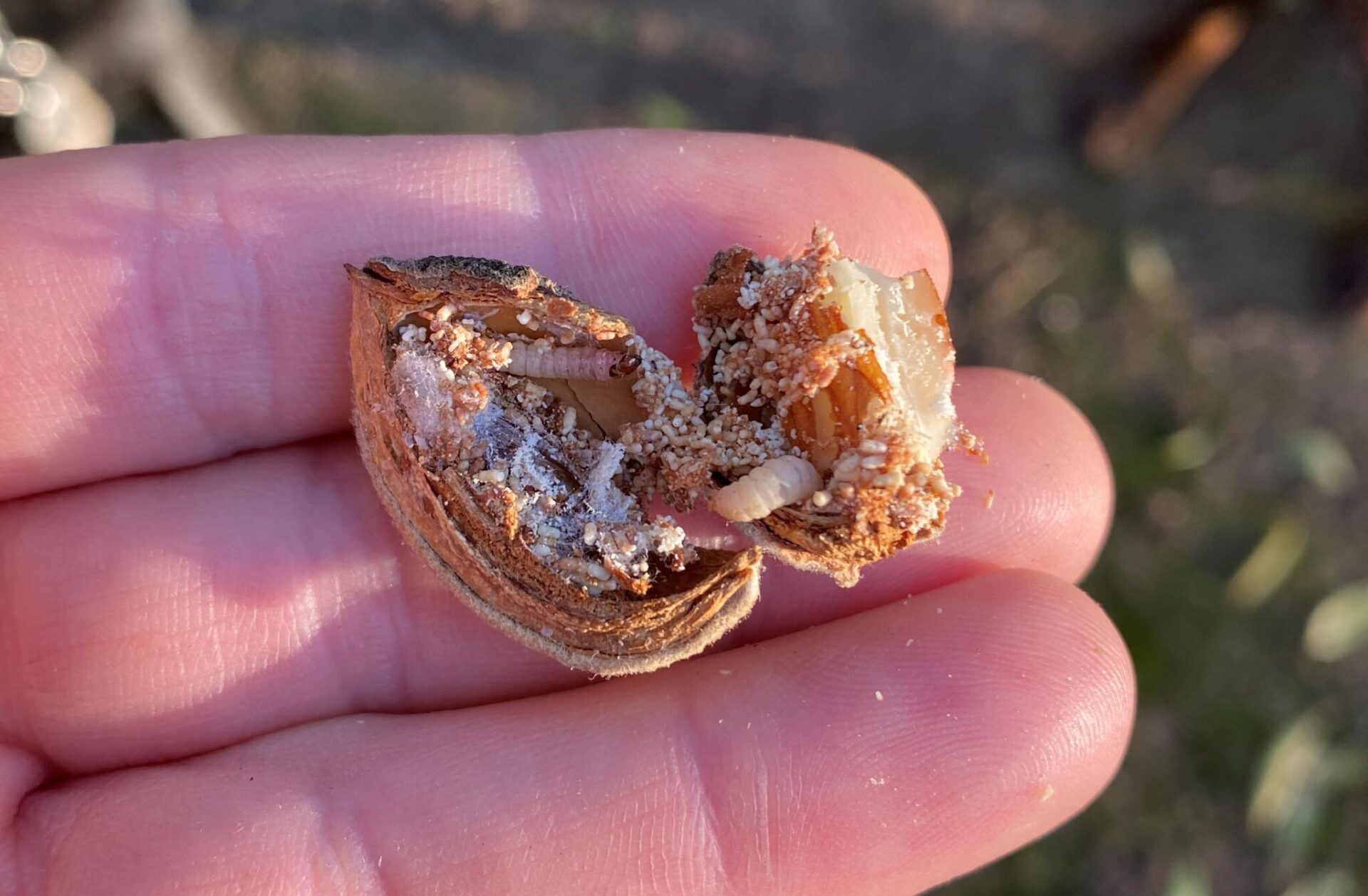Mating disruption for navel orangeworm (NOW) has been a commercial pest management option in California nut crops for several years as the 2021 growing season nears. With both continued use and expansion into acres new to mating disruption since 2014, many growers may be multiple seasons into their implementation. For others, 2021 may be the first year of incorporating NOW mating disruption technology into their overall nut crop IPM program. And some may still be considering whether to adopt this approach on some or all of their acreage. As our collective knowledge about the applied use of NOW mating disruption matures, we are in a good place to reflect on lessons learned from several years of real-world applications and case studies. We can begin to shift some focus from, “Why use mating disruption?” (benefits and efficacy have been consistently demonstrated) to discussing best practices for success and how to confidently work within a mating disrupted system.
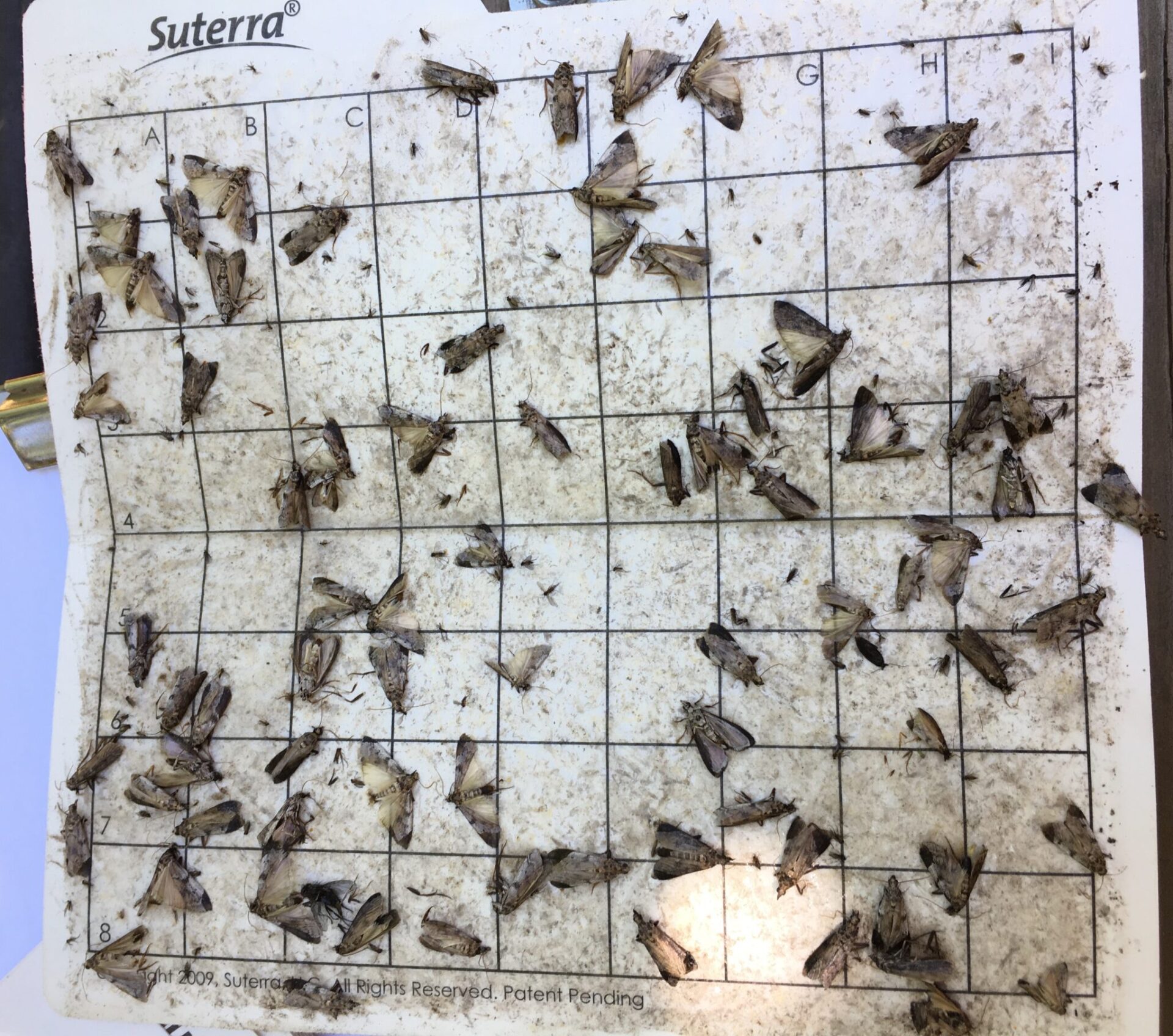
Mechanism of Action
It is important to understand and trust the mechanism of action of mating disruption. Insect chemical ecology as a field of study is not new, with the first insect sex pheromone identification dating back to 1959. Nor is the concept and applied use of mating disruption as an effective agricultural pest management tactic, first demonstrated in 1967. Successful aerosol-based mating disruption technology research efforts date back to the mid-1990s, and commercialized aerosol mating disruption has been available since 1998. But why is this mechanism of action so reliable? The physiology of pheromone-based communication among insects and the behaviors elicited are highly specific to a given species, and innately tied to their evolutionary success (i.e. reproduction). For this reason, we are able to exploit this part of their biology for purposes of pest management, reducing populations in a consistent and reproduceable manner.
This confidence in mechanism of action should be equal to that of insecticides, where specific aspects of insect physiology (whether nervous, metabolic or growth system pathways) are targeted, resulting in the desired effect. It is, however, important to appreciate the differences between mating disruption and insecticide mechanisms. Unlike insecticides, mating disruption does not kill the organism outright, but rather reduces the number of viable offspring in the next generation, and as a result, reduces the population potential in all subsequent generations as well. Mating disruption is considered a non-contact approach, meaning that the active ingredient (pheromone or pheromone blend) must only be in the environment at desired concentrations to confuse males and thereby reduce mating and female fertility. Conversely, the insecticides most relied upon for NOW management require direct contact with or ingestion by the pest at the targeted life stage, necessitating exceptional coverage with each application to maximize efficacy. As opposed to insecticides, mating disruption is highly species-specific, which eliminates negative non-target effects to all other organisms and the environment. The action is also specific to males in the case of NOW, which means that it cannot protect from immigrating females that were mated outside of the disruption-treated area. All of these are essential to keep in mind when we discuss evaluating mating disruption within the overall IPM program.
Choosing a Pheromone Product
There are different pheromone delivery system options (“platforms”) available, and consideration should be given to which platform best fits your pest management needs and operation. The three commercially available platforms include aerosol emitters, sprayable microencapsulated formulations and medium-density dispensers. Aerosol emitters (one per acre) and dispensers (15 to 28 per acre) are typically placed just ahead of the first flight in spring and provide season-long pheromone mating disruption coverage. The sprayable formulation, currently only produced by Suterra, is the latest in NOW pheromone release technology and is active for up to 30 days. It can be applied using traditional spray equipment (ground or aerial), low or ultra-low volume spray equipment or drones.
The active ingredient (pheromone itself) is the same molecule across all NOW mating disruption platforms and products. However, even within similar product platforms, such as aerosols, it is important to note that not all products are created equally. Co-formulants as well as the device itself (its durability, stability, release mechanism) can result in differences in getting the pheromone out into the environment reliably, and thus the effectiveness of disruption in reducing populations and crop damage. A dependable pheromone delivery system is critical to achieve the mating disruption mechanism of action as described above. The decision on which platform and product is best suited for a given operation should be based on conversations among growers, their pest control advisers and product manufacturer technical representatives to ensure that everyone is on the same page regarding functionality, reliability, labor requirements and expectations for efficacy. Regardless of chosen platform, mating disruptants should always be deployed according to product-specific guidelines, and for aerosols and dispensers, according to the appropriate map layout for each individual orchard block. Most manufacturers offer mapping services, and some offer individually-tailored deployment training.
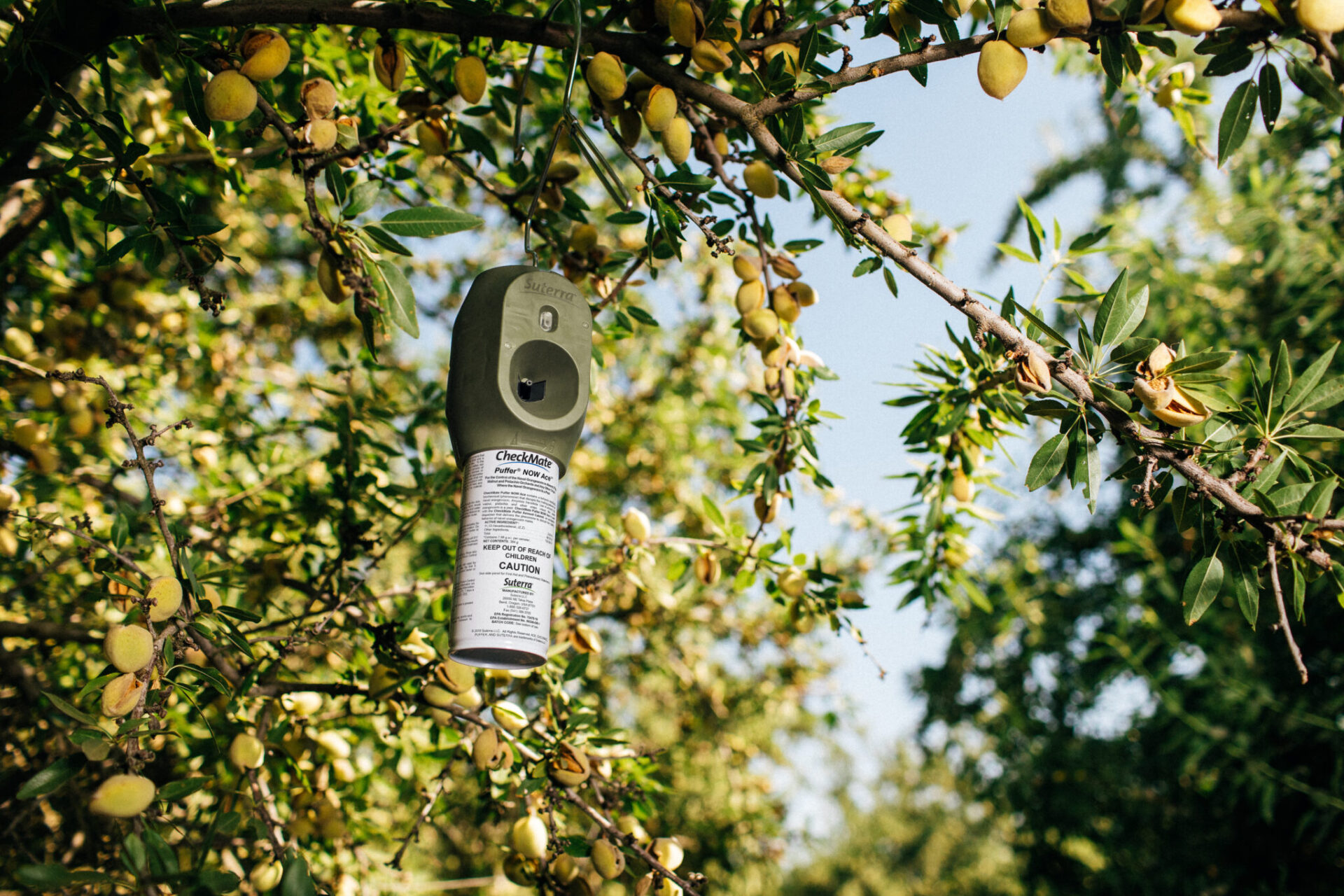
Successful Incorporation into Your IPM Program
Agroecosystems are complex and exist within broader landscapes. The biology and ecology of NOW make it a very challenging pest to manage to the low levels required due to the direct nature of crop damage and aflatoxin contamination potential. For these reasons, it is understood industry-wide that a comprehensive IPM approach is necessary to achieve damage standards. NOW mitigation strategies often require use of all available management tools to one degree or another (mating disruption, sanitation, timely harvest, minimizing other sources of damage and factors that contribute to mummy development, as well as insecticides as warranted by pest pressure and informed by monitoring.) While a valuable component of an overall NOW mitigation strategy, mating disruption, like every other NOW management tactic, is not a standalone magic bullet in every situation.
Adopting any new or evolving technology within an overall IPM program presents a learning curve and opportunities for continued refinement. Consider the pitfalls and adjustments necessary when shifting from broad-spectrum to more selective insecticides; more attention has been required to achieve efficacy based on precision application timings and coverage requirements. With all NOW management tactics, many factors have the potential to impact efficacy and return-on-investment. For developing and evaluating a successful mating disruption program, specific considerations should include block size and shape, area under mating disruption, duration of mating disruption, historical pressure, information obtained from in-season and dormant monitoring, reliability of the chosen mating disruption platform and product, landscape factors, potential for immigration and efficacy of other tactics (e.g. sanitation, insecticides).
When designing and evaluating a mating disruption program, continue to keep in mind the difference in mechanism of action in contrast to insecticides. With this proactive approach, rather than attempting to directly influence mortality of adults or larvae with insecticide applications, we are preventing the larvae from existing in the first place by reducing or eliminating mating and viable egg-laying during the flight. Season-long disruption tactics like aerosols and dispensers are continually “running in the background” to have this impact, but this is not a “set it and forget it” approach. Mating disrupted orchards continue to require comprehensive boots-on-the-ground monitoring programs to evaluate impacts and determine if, where and when supplemental reactive measures like insecticides are needed. These in-season monitoring activities, along with harvest damage evaluations, will inform the degree to which other management tactics can be reduced or even eliminated during the current season or in subsequent years.
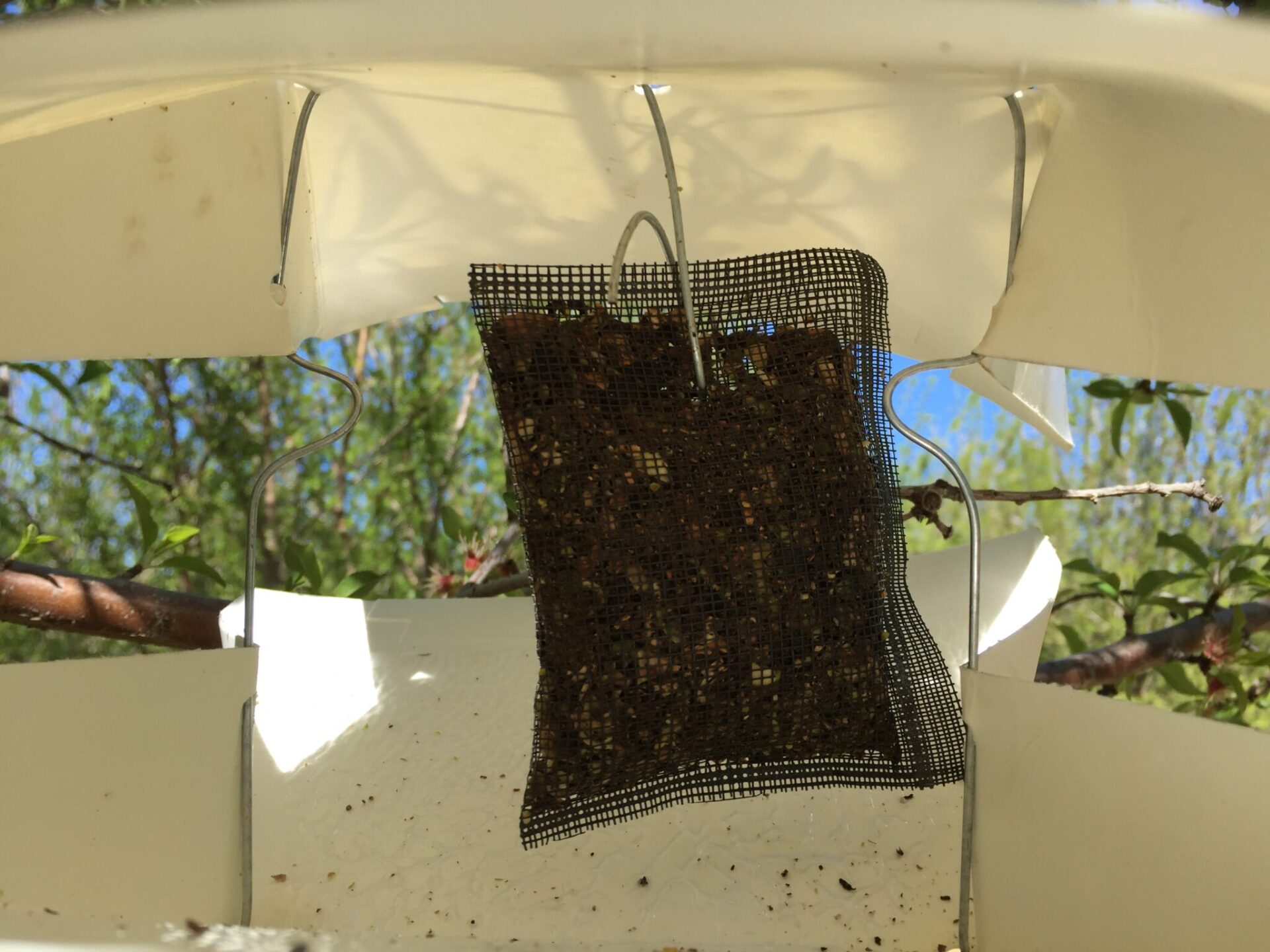
Monitoring NOW within Mating Disruption Systems
Monitoring to obtain knowledge for decision-support is crucial for any IPM program. There are several options for monitoring NOW, and understanding the utility of each method is important in both mating disruption and non-mating disruption orchards alike. Research has shown that a combination of monitoring methods is the best strategy for informing NOW treatment needs and timing. In mating disrupted orchards, the presence of pheromone in the environment impacts male capture in traps baited with pheromone lures; therefore, additional reliance on alternative monitoring approaches is required. Revisiting the basics of each available NOW monitoring method, particularly in the context of mating disruption, is worthy of an entire dedicated article. For purposes of the current discussion, below is a brief summary of how each can be used in mating disrupted orchards.
Pheromone traps target adult males only and should be deployed in mating disruption blocks to confirm presence of mating disruptant pheromone activity. Significant trap suppression should be observed as long as aerosol and dispenser platforms are present, and for up to 30 days after a Flowable application. Increases in pheromone trap capture can inform best times to apply or re-apply Flowable. Pheromone traps, along with crop damage, are an effective way to evaluate mating disruption efficacy.
Egg traps can be used in mating disruption orchards as they are used in non-mating disruption orchards because female trap location ability is not impacted by mating disruption. Utility of egg traps includes establishment of biofixes, degree day modeling, larvicide timing, and may indicate relative population abundance (block to block, year to year). Egg traps are not an effective way to measure mating disruption efficacy as eggs deposited on egg traps may or may not be viable. Eggs laid by a virgin female are not viable, and produce no larvae.
Kairomone (e.g. bait bag or Peterson traps) can be used in mating disruption orchards as they are used in non-mating disruption orchards because female trap location ability is not impacted by mating disruption. These traps target adult females almost exclusively and are considered less sensitive than pheromone traps, meaning they have a smaller attractive radius and often catch a much lower total number of moths relative to pheromone traps (where mating disruption is not present and suppressing pheromone trap capture.) Kairomone-based traps remain useful to track female flight activity under mating disruption, and may indicate relative population abundance. It is unclear whether bait bag trap data is indicative of mating disruption efficacy.
PPO+Pheromone traps have been shown in recent research led by USDA entomologist Chuck Burks to be effective for monitoring NOW in mating disruption blocks. Phenyl propionate lures paired in a trap with standard NOW pheromone lures attract both males and females in mating disruption and non-mating disruption orchards, and can therefore be used to track flight activity and may indicate relative population abundance. It is unclear whether PPO+pheromone trap data is indicative of mating disruption efficacy.
Mummy samples and infest rates over the winter should be conducted to help set sanitation priorities and estimate block-specific pest pressure going into the season. This knowledge can help inform mating disruption platform and NOW mitigation strategy choices.
Crop phenology is monitored to determine timing of peak in-season crop vulnerability (i.e. the onset of hull split through harvest), and can be paired with visual observations of egg laying directly on the crop. This window of in-season crop susceptibility is a critical time for potential insecticide applications as well as possible targets for timing Flowable applications.
Harvest damage evaluations are critical to evaluating the overall IPM program. Processor grade sheets provide good information for the grower but may lack in specificity regarding the exact source of the damage. Obtaining and cracking out in-orchard harvest samples provides the best information about sources of crop damage as well as a more accurate measure of crop lost to NOW as NOW-damaged nuts may not make it all the way through harvest processes for grade sheet inclusion.
Evaluating your IPM Program
Determining the efficacy and return-on-investment (ROI) of your NOW program necessitates a comprehensive review of all of the tactics that were employed. For example, were sanitation goals met? Were insecticides applied at the most effective timing(s) and was coverage adequate? Were there impacts from NOW immigrating in from surrounding orchards? Did the mating disruption platform and product perform as expected? While there may be a natural predisposition to desire a strict dollars-and-cents ROI analysis from each crop input individually, it can be difficult in practice to distinguish separate impacts, especially for pests like NOW for which multiple management tactics are often used. Research has consistently shown significant reductions in damage in the first year of mating disruption adoption, often recouping the cost of the product and then some in many cases. Remember, however, that a mechanism like mating disruption, which is based on long-term population suppression, will show compounding financial ROI benefits year-over-year with sustained use. There are also the less directly tangible economic and ecological returns from incorporating mating disruption (e.g. resistance mitigation, preserving beneficials, sustainability certifications, etc.) that need to be considered when evaluating this tactic as a crop input.
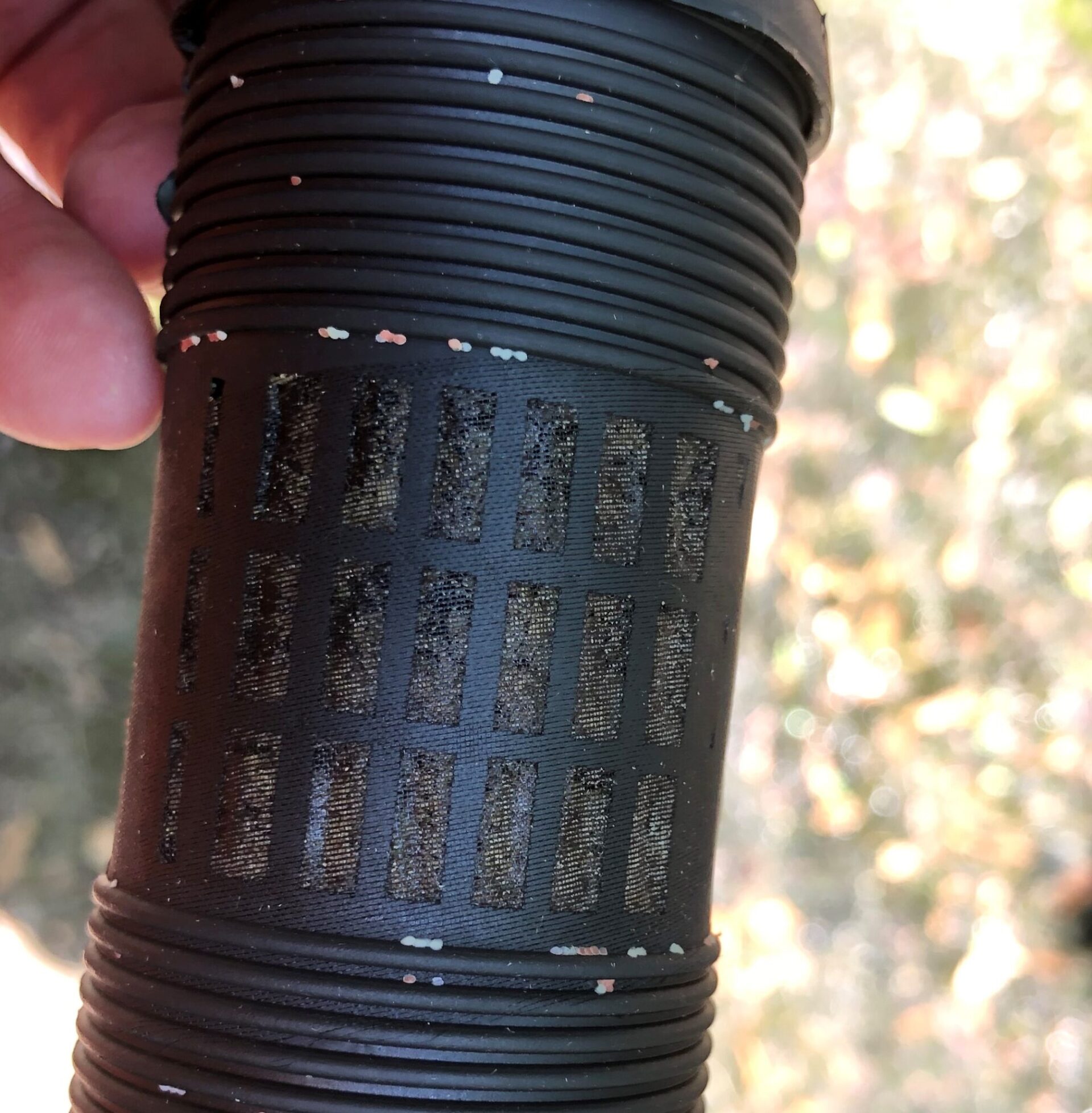
Stay the Course
Mating disruption should be considered a long-term investment toward mitigating the negative impacts of NOW populations in agroecosystems. Be cautious when considering discontinuing its use, whether due to reduced pest pressure or necessary cost-saving measures based on crop prices or market uncertainties. Consider the longer-term impacts and your investment to date as well as the fact that mating disruption itself is likely a big reason for the downward trend in pest populations. Carefully evaluate whether other types of less desirable or more costly inputs can be reduced while maintaining a disruption environment. Over the course of 2020, we have heard from academics, extension agents, growers and PCAs alike that NOW IPM programs incorporating mating disruption are working to suppress populations and generate quality bonuses, and that we need to continue to keep the pressure on (not let our foot off the gas, so to speak) when it comes to this pest.
There are many wonderful resources available for growers, operations managers and PCAs to support successful adoption of mating disruption into your IPM programs. Manufacturer technical service representatives, cooperative extension agents and others are readily available to meet with you and help determine the best fit for your operation and how to get the most out of your investment. Best wishes for a successful 2021!
For additional information, the author can be contacted at Emily.symmes@suterra.com.







